Sixth Lecture Series on the History and Culture of Central Asia
During the winter term 2023/2024, the sixth
Lecture Series on the History and Culture of Central Asia
entitled “Courts and their Arts in Central Asia: from Palaces to Poetry”, will take place. For this term four lectures are planed:
- 1st lecture: Tuesday, October 17th 2023, 1-3 p.m. CET / 4-6 p.m. Tashkent Time via Zoom.
- 2nd lecture: Tuesday, November 14th 2023, 1-3 p.m. CET / 4-6 p.m. Tashkent Time via Zoom.
- 3rd lecture: Tuesday, December 12th 2023, 12-2 p.m. CET / 3-5 p.m. Tashkent Time via Zoom.
- 4th lecture: Tuesday, January 16th 2023, 12-2 p.m. CET / 3-5 p.m. Tashkent Time via Zoom.
Zoom login data:
Meeting ID: 525 843 6902
Password: 12345
Oct. 17, 2023 - Feruza Jumaniyazova - " The Harmony of Turkic Traditions in "Royal Gatherings" in Tokharistan and Tibet""
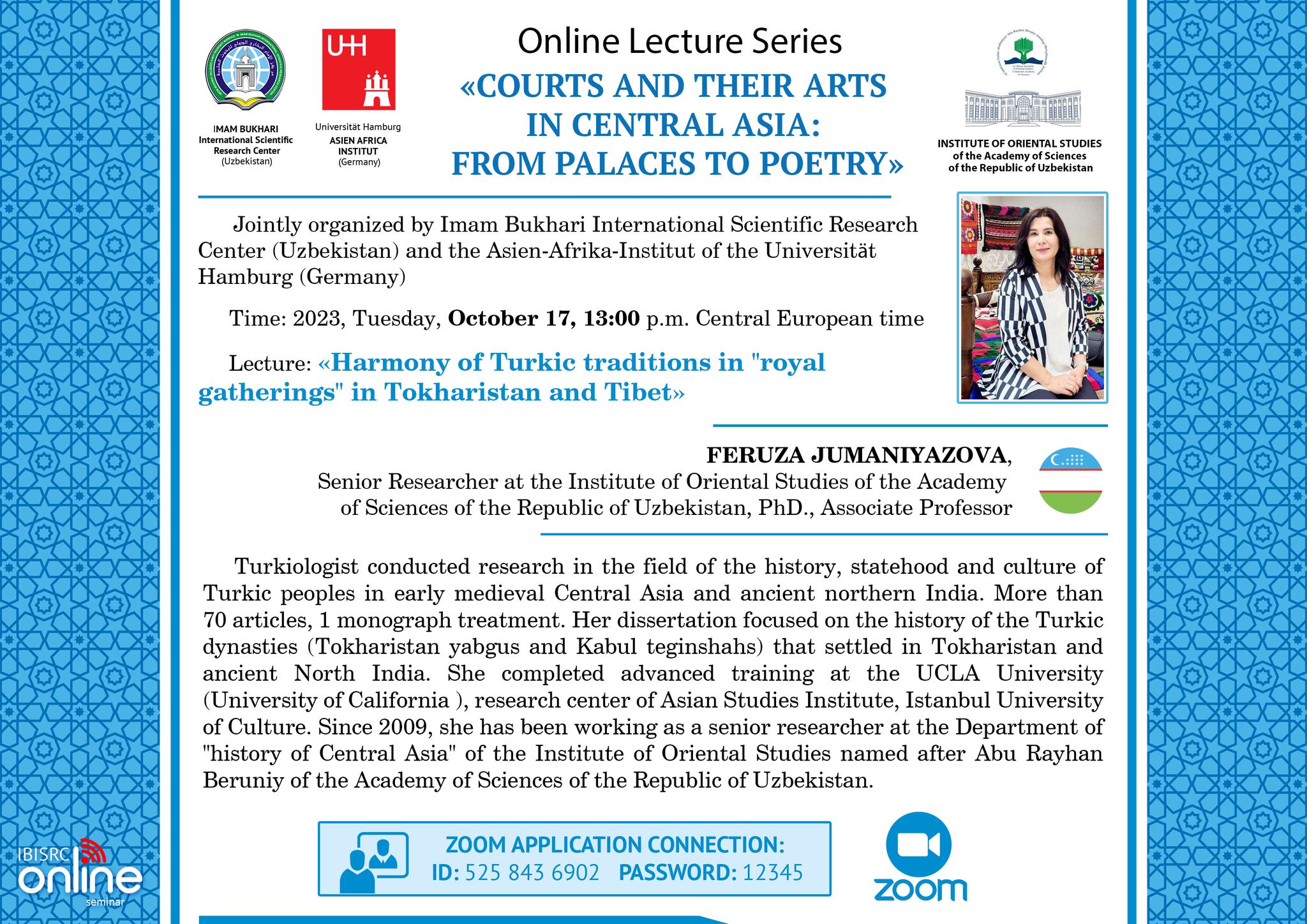
The sixth lecture series on the history and culture of Central Asia, titled “Courts and their Arts in Central Asia: from Palaces to Poetry”, jointly organized by Imam Bukhari International Scientific Research Center (Uzbekistan) and the Asien-Afrika-Institut of Universität Hamburg which takes part during the winter term 2023/2024, kicked off on October 17th, 2023. Feruza Jumaniyazova, associate professor at The Institute of Oriental Studies of The Academy of Sciences of the Republic of Uzbekistan gave a lecture on “The Harmony of Turkic traditions in “royal gatherings” in Toharistan and Tibet”.
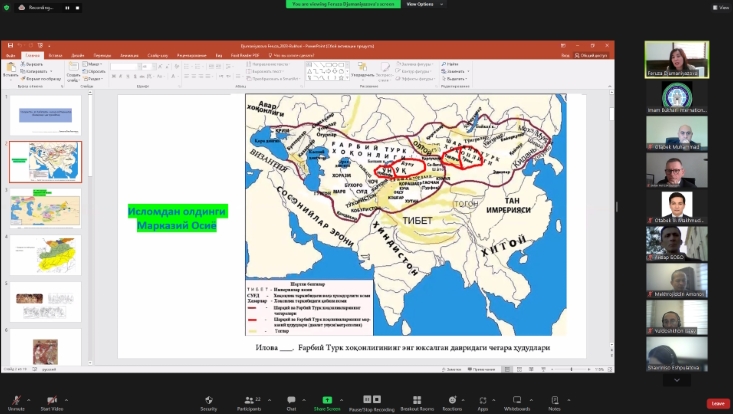
Photo: IBISRC
She spoke about the famous photo “the scene of the royal drinking”, which was painted on the wall of the Duhang temple in one of the Tibetan villages, saying that this is a rare case when a secular scene is present among the images on the wall of a Buddhist temple in Tibet. Jumaniyazova noted that the iconographic analysis aimed at identifying artistic trends in the scene and placing them in a certain cultural context, while also noting that previous researches failed to identify the causes of external influences on the fresco.
She also spoke about the life of the Turkic peoples in the early Middle Ages, using the example of wall paintings, sculptures, iconographic references to “royal feasts” on coins found in such objects as Bolaliktepa in the Toharistan region. By comparing them with the drawings on the wall of the Johan Monastery, she showed that the Turkic peoples were actively involved in the socio-political and ethnomathematical processes taking place in Tibet and the neighbouring regions of that time.
Relations between the Turkic peoples and Tibetans have been established not only in the political, but also in the economic and cultural spheres, which requires a deeper study of the issue, she concluded.
Source: The Press Service of Imam Bukhari International Scientific Research Center
Nov. 14, 2023 - Ahmad Khan - "Law and Society in Medieval Khurasan and Transoxiana: Shurūṭ Works "
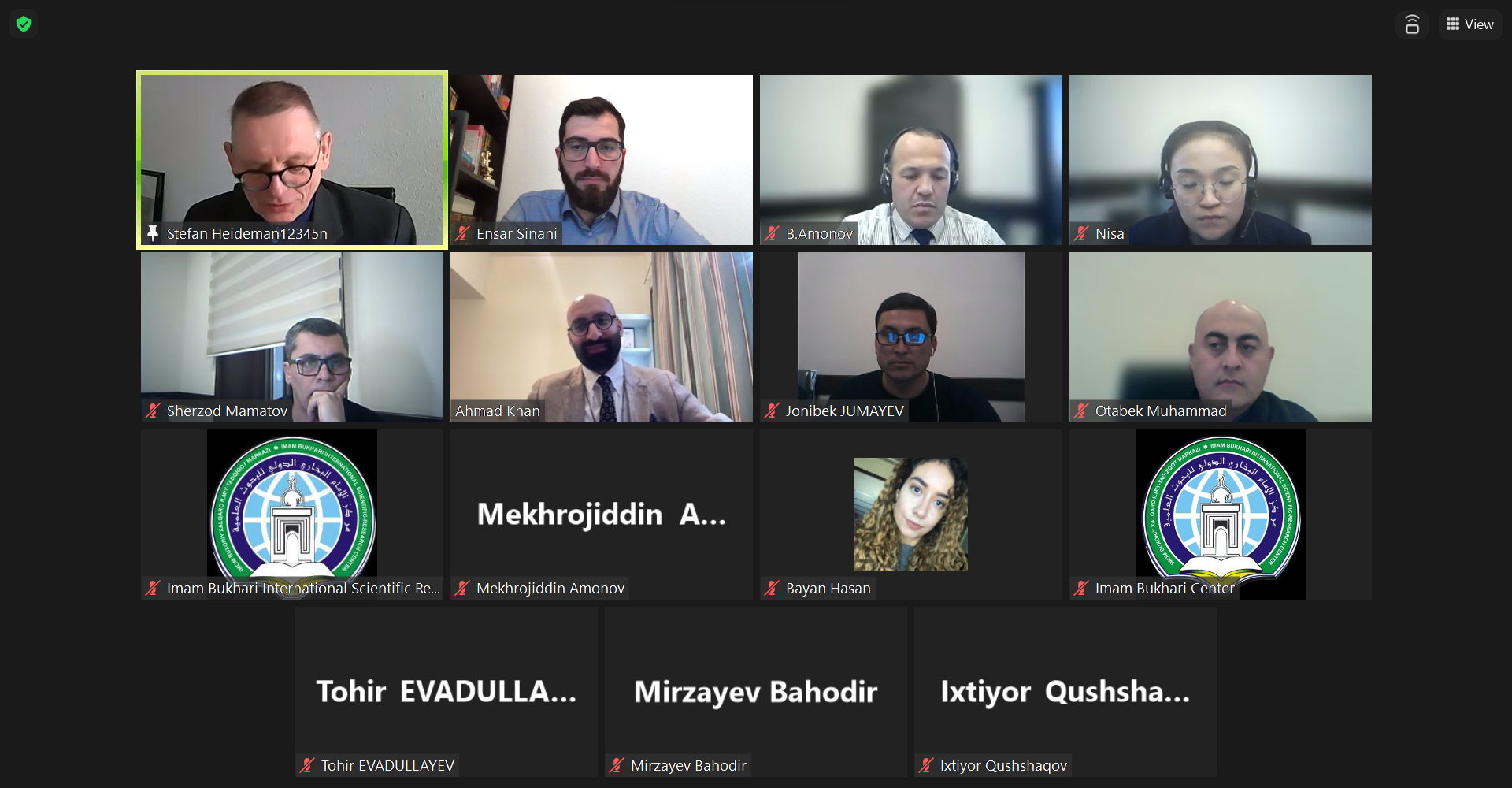
The second lecture of the winter term's series, was held by Dr. Ahmad Khan, assistant professor of Islamic Studies at The American University in Cairo (AUC) on November 14th, 2023 online via Zoom. It discussed the topic of "Law and Society in Medieval Khurasan and Transoxiana: Shurūṭ Works".
Abstract:
Shurūṭ Works have an ambivalent status in the study of Islamic law and society. These are works, composed first in the ninth century, that provide model contracts for a wide range of legal transactions and agreements. They seem to have originated in the Qadi's office, where scribes and notaries would draft contracts. Modern scholars, working mainly based on Iraqi and Egyptian shurūṭ works, have debated the extent to which shurūṭ works reflect legal doctrine and historical practice. This lecture provides a history of shurūṭ works in medieval Khurasan and Transoxiana. It will examine what they can tell us about legal doctrine and social practice in the eastern provinces of the Islamicate world.
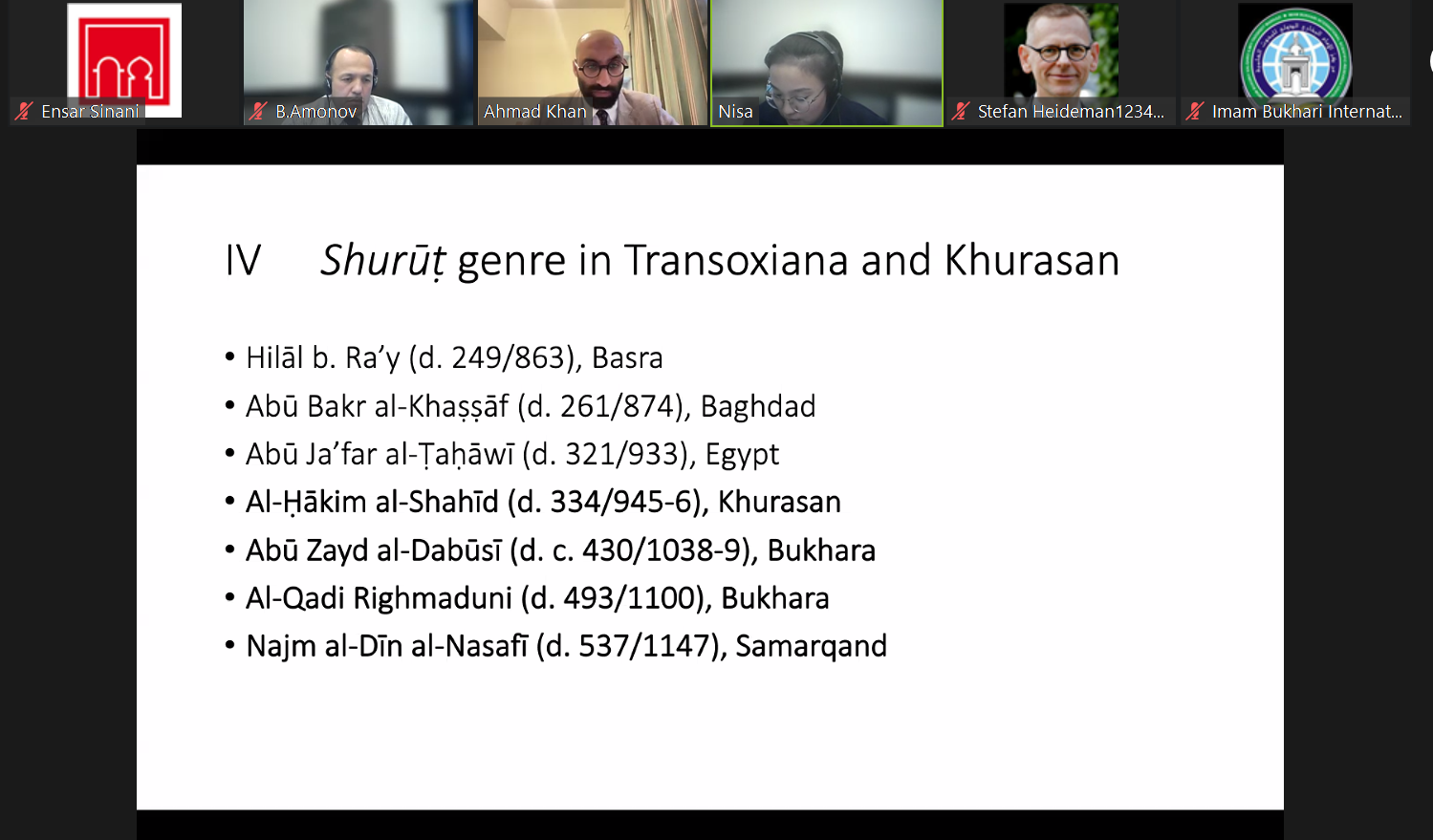
Short Bio of the Lecturer:
Ahmad Khan is an assistant professor of Islamic Studies at The American University in Cairo (AUC). His research focuses on classical Islamic thought (tafsir, hadith, law, and sufism) in its intellectual, social, and historical contexts. His first book, a co-edited volume, explored medieval and modern Islamic thought: Reclaiming Islamic Tradition: Modern Interpretations of the Classical Heritage, Edinburgh University Press. His second book examined the formation of medieval Sunnism, with a focus on debates over orthodoxy and heresy, Heresy and the Formation of Medieval Islamic Orthodoxy: The Making of Sunnism, Cambridge University Press (2023). He is currently finishing his third book, looking at Islamic law and society in medieval Khurasan. Khan received his DPhil from the University of Oxford, Faculty of Oriental Studies, where he also completed his MPhil. Khan joined The American University in Cairo (AUC) as an assistant professor in 2018. Prior to AUC, he worked at Oxford and Hamburg universities. In 2022, he was appointed the Arcapita visiting professor at Columbia University in New York.
Dez.12, 2023 - Fahriddin Ibragimov - "Trends in the Study of Avicenna´s Legacy in Iran"
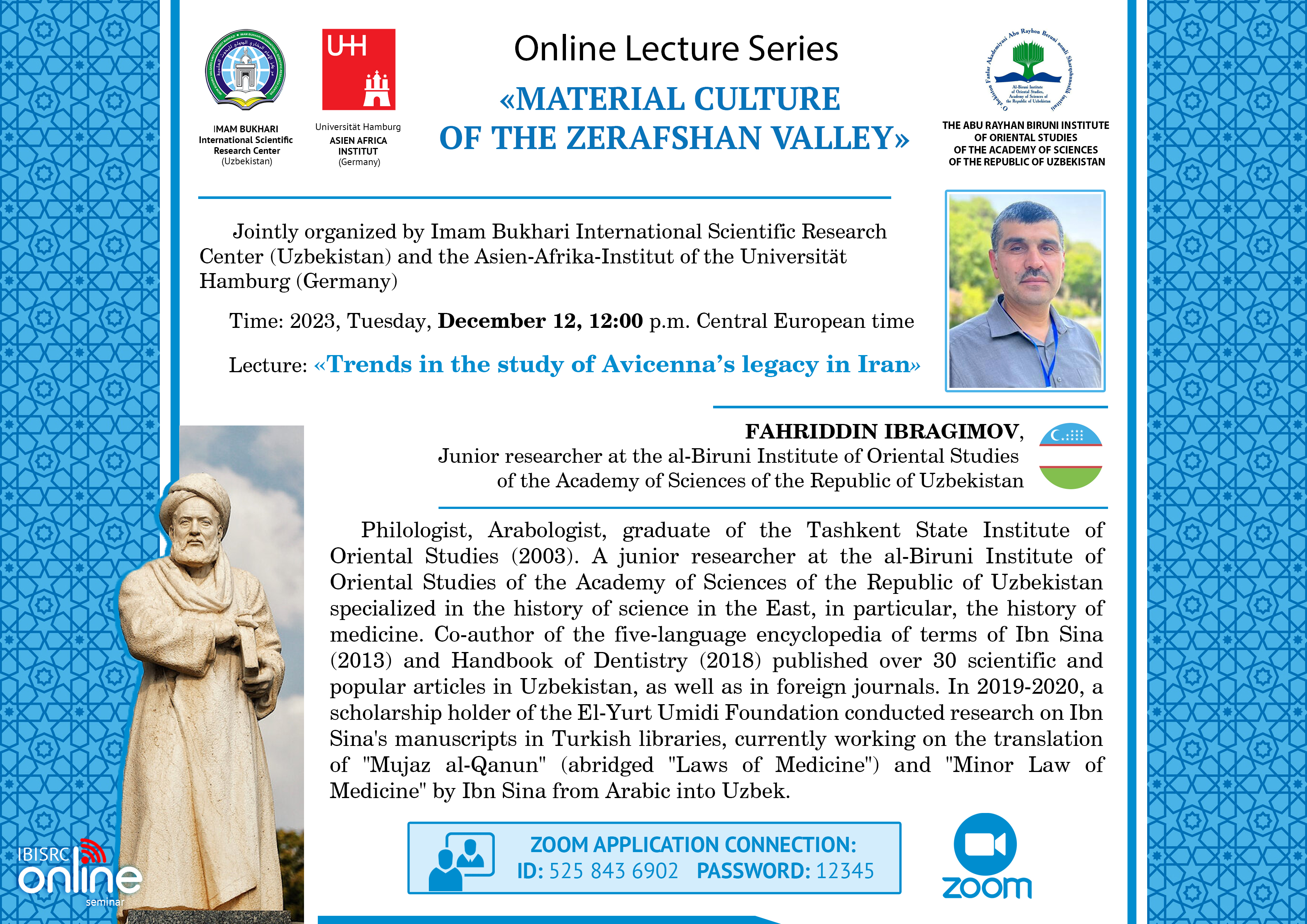
This winter term`s series on the history and culture of Central Asia went on with the lecture of Dr. Fahriddin Ibragimov on "Trends in the Study of Avicenna´s Legacy in Iran", which took place on December 12th, 2023, at 12 am CET, online via Zoom.
Ibragimov emphasized the serious attention paid to the study of Avicenna`s legacy in Iran, noting that since Avicenna wrote most of his works in Iranian cities and his grave is located in Hamadan, in Iran he is even being considered Persian, although he never declared himself as such.
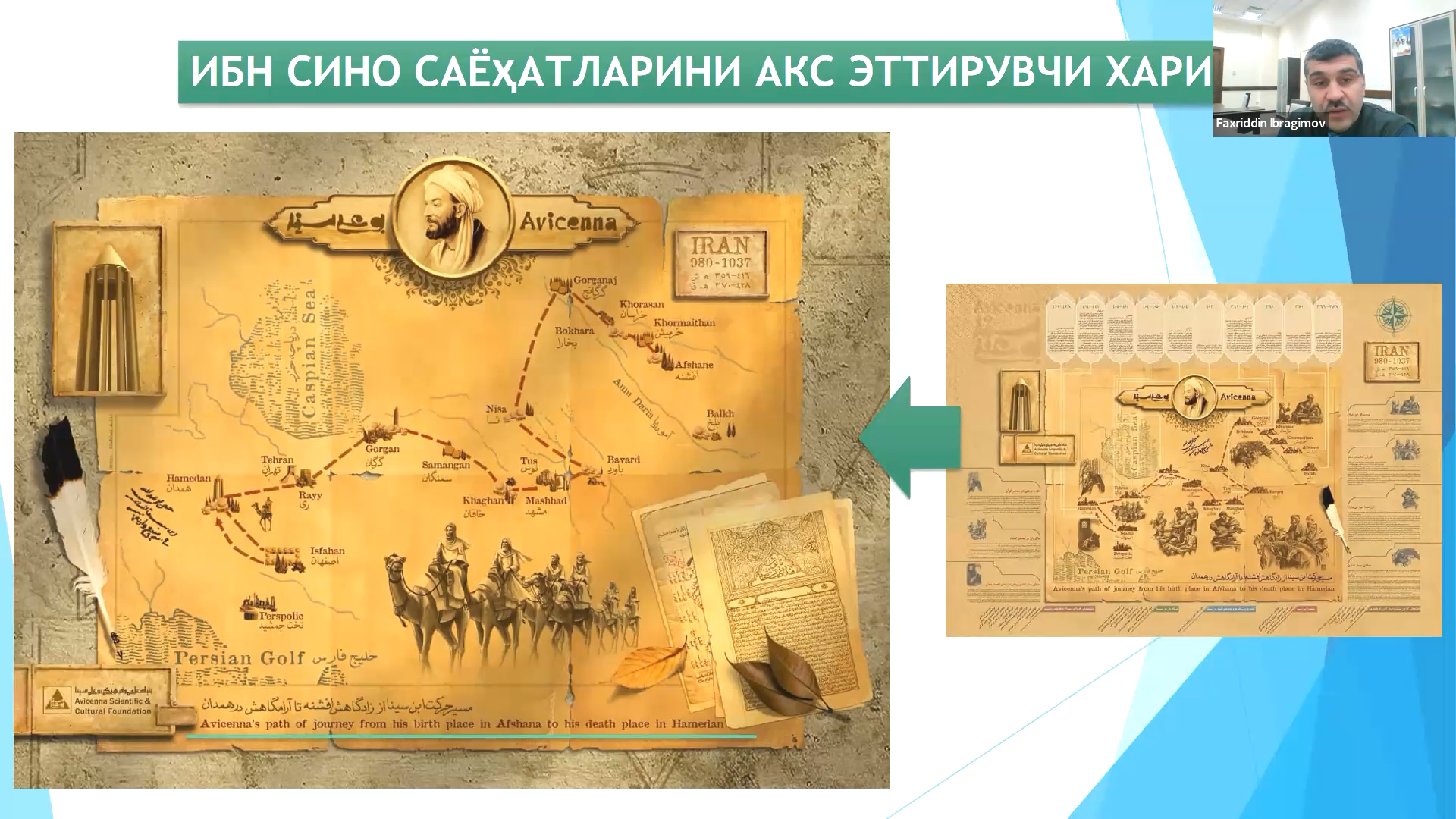
From the 50s of the last century to the present, 45 doctoral dissertations devoted to the life and scientific heritage of Avicenna have been defended in Iran, clearly showcasing the great sceintific attention paid to him. In addition, the International Ibn Sina Foundation in Hamadan and the Institute of Philosophy in Tehran play a key role in the research and popularization of Ibn Sinas’s legacy there.
According to Ibragimov, the study of Avicenna’s legacy in Iran can be divided into two periods: from the 1950s to the 1980s and from the 1980s to the present. The first period mainly covers research on the life, scientific activities, and bibliography of his works, while in the second period, critical studies on the works of Avicenna were conducted and from western languages into Persian translated.
Short bio of the speaker:
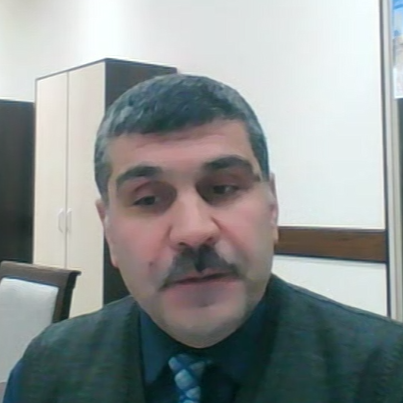
Fahriddin Ibragimov, holds a PhD Degree from the Tashkent State Institute of Oriental Studies (2003). He is is a philologist and arabologist currently working as a junior researcher at the Al-Biruni Institute of Oriental Studies of the Academy of Sciences of the Republic of Uzbekistan. His focus of research lies on the history of science in the East, particularly the history of medicine. He is co-author of The Encyclopedia of the Terms of Ibn Sina, published in five languages (Tashkent, 2013) and the Handbook of Dentistry (Tashkent, 2018) besides publishing over 30 articles in Uzbeki and international journals. Currently, Fahriddin Ibragimov is working on the translation of "Mujaz al-Qanun" by Ibn al-Nafis and "Minor Law of Medicine" by Ibn Sina from Arabic to Uzbek.
Jan.15, 2024 - Eylor Karimov - "Kubraviyya: Known and Unknown (The Waqf of Husayn Khorezmi in Samarqand)"
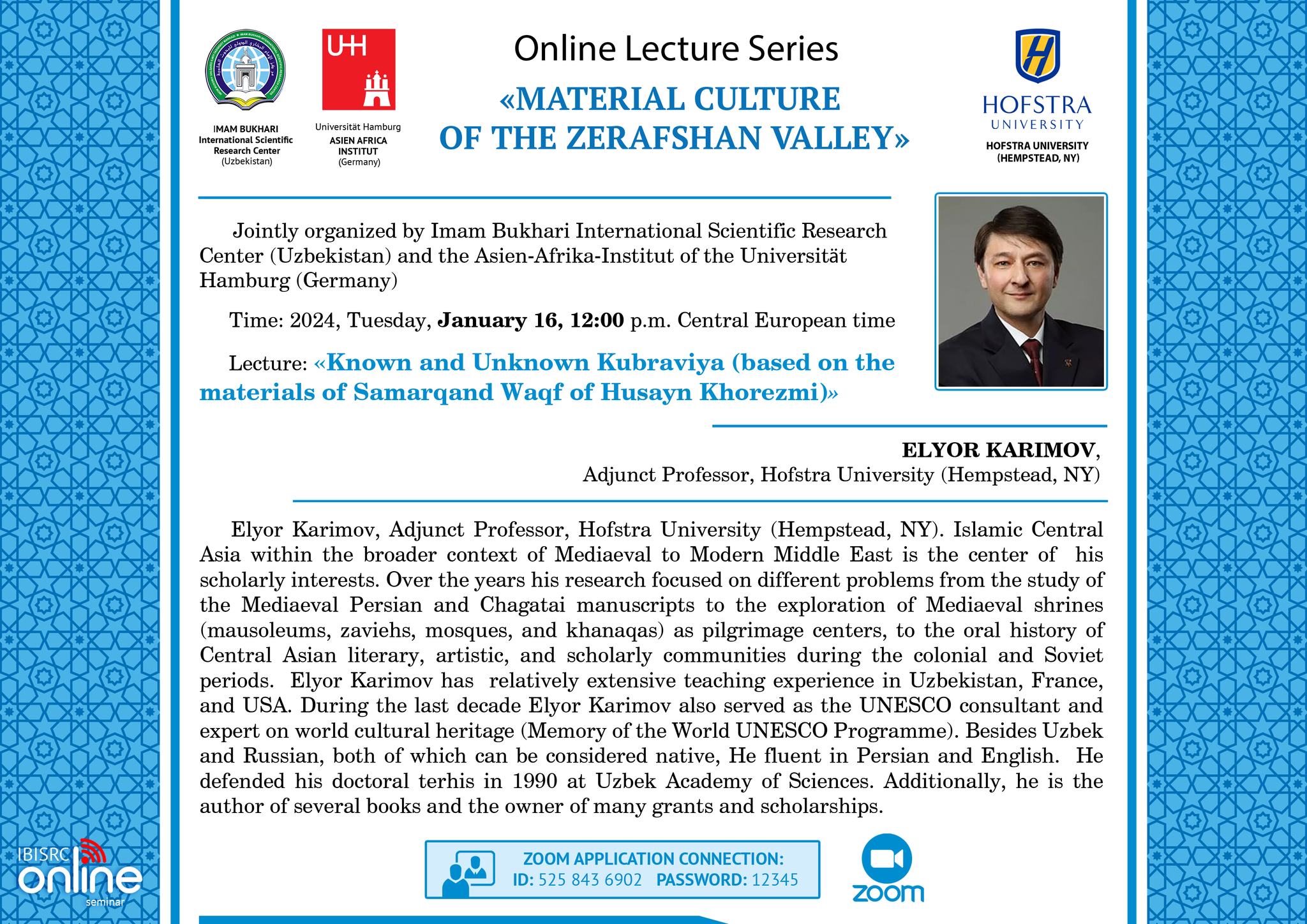
This winter term`s series on the history and culture of Central Asia ended with the lecture of Dr. Eylor Karimov, Adjunct Professor at the Hofstra University (Hempstead, New York) on "Kubraviyya: Known and Unknown (The Waqf of Husayn Khorezmi in Samarqand)", which took place on January 15th, 2024, at 12 am CET, online via Zoom.
Karimov initially spoke about the origin and spread of “Kubraviya”, as well as about mature representatives in Central Asia, and also highlighted a number of contradictions and shortcomings found in some studies of the social, political and economic history of the brotherhood. He then focused on the personality, life and activities of Husayn Khorezmi, the authorized representative and adviser to the Timurid ruler, who founded a big Waqf-Endowment for the Kubraviyya brotherhood. According to Karimov , Khorezmi’s waqf deed "Qaqf-Nama” will shed new light on the unknown pages of the history of “Kubraviya” in Central Asia. This work, which has great historical significance, containing a list of lands, gardens and mills, conditions for using waqf territories, the composition of the ministers of the khanate, their duties and annual financial allocations, shows that the Kubraviya sect had preserved its authenticity.
Abstract:
The Kubraviyya Sufi tariqa, alongside with other Sufi brotherhoods as the Yasaviyya and Naqshbandiyya Orders, is one of the main autochthonous brotherhoods established in Central Asia. Nevertheless, the study on the social, political, and economic history of the Kubraviyya remains full of contradictions and gaps. As with all historical problems, the complexity of studying the Kubraviyya tradition is determined by an insufficient amount of historical written sources that would allow researchers to assess this Sufi brotherhood in a more nuanced historical perspective.
While the history of the founding of the Kubraviyya and its early development are not controversial, the study of more recent periods is, because of missing historical information. In a relatively short time, the Kubraviyya held a strong position in Central Asia.
Moreover, this tariqa can be credited as being a pioneer in the political, public, and economic domain. Who among Najm ad-Din Kubra’s disciples remained active and became either well-known theologists of a mystical way, or the authors of classical works on Sufism, or people who contributed to the solidifying and spreading of Islam in general?
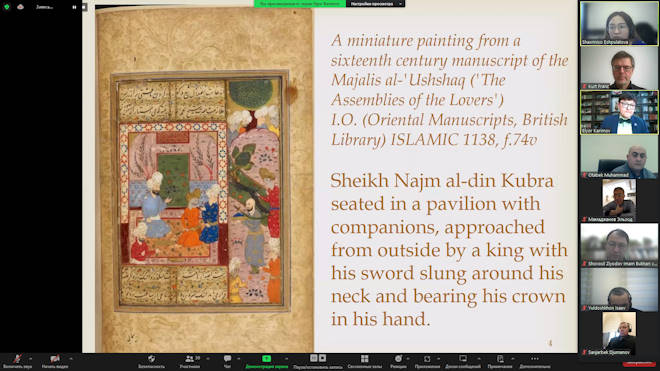
One of his most famous disciples in Central Asia is Shaykh Kamal al-Din Husayn Khwarazmi. Only few facts are known concerning the life and activity of Shaykh Kamal al-Din Husayn Khwarazmi. These information were repeated all over in a multitude of studies: The role of Husayn Khwarazmi is being limited to a ‘brief revival of the former power and influence of Kubraviya’ (O.F.Akimushkin) and ‘Kubravi presence in the Turkic milieu on the frontiers of the Islamic world down to the early 15th century’ (D. DeWeese).
A whole new layer of information is provided by the Samarqand Waqf-nama of Husayn Khwarazmi that has escaped the attention of most of the researchers. This unique document was first described by R.G. Mukminova in 1965 and more recently, in 2008, the presenter published its full text. The Waqf-nama of Husayn Khwarazmi allows us to throw new light on the still unknown pages of the late history of Kubraviyya in Central Asia.
Short bio of the speaker:
Elyor Karimov is an Adjunct Professor at Hofstra University since 2017, he obtained his Ph.D. in 1990 from the Uzbek Academy of Sciences. His doctoral dissertation focused on the social positions of clergy in 15th-century Maverannahr. Later, in 1998, he earned a Sc.D. with a thesis centered on Sufi tariqats in Central Asia between the 12th and 15th centuries.
Karimov's scholarly interests primarily revolve around Islamic Central Asia in the context of the broader Mediaeval to Modern Middle East. His research spans diverse subjects, including the study of Mediaeval Persian and Chagatai manuscripts, exploration of pilgrimage centers like mausoleums and mosques, and investigation of Central Asian literary, artistic, and scholarly communities during colonial and Soviet periods.
He has authored and co-authored several books, including "Religion Made Official: a Comprehensive Collection of Documents from the State Archives of Soviet Uzbekistan, 1920s – 1960s" with David Abramson (2009) and "The Kubraviya Waqf (17th-19th Centuries): Written Sources on the Late History of the Kubravi Sufi Brotherhood in Central Asia" (2008).

